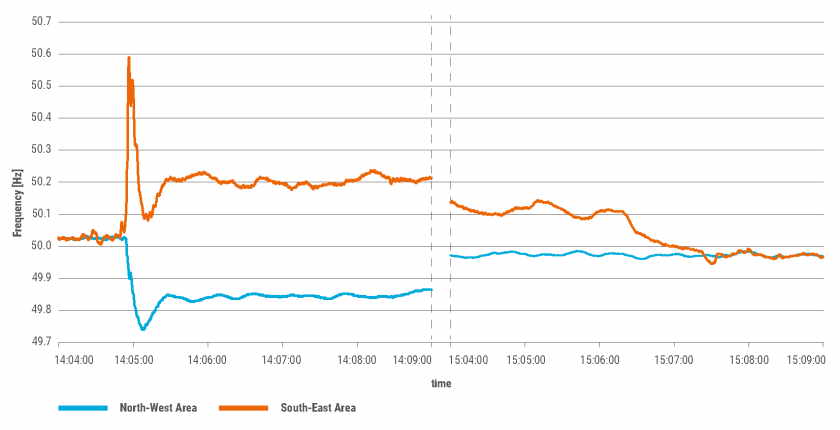
Due to outages of several transmission network elements, the Continental Europe synchronous area was split into two grid regions on January 8, from 14:05 to 15:08 CET. This is the second time this kind of event has taken place.
The European Network of Transmission System Operators (ENTSO-E) has unveiled the first details of the incident which led to a decrease in frequency in North-East Area and an increase in frequency in South-East Area, and the disconnection of 233 MW of supply to customers.
The two areas were separated along the route shown in the image above.
“In line with the provisions of the System Operation Guideline, a detailed investigation is ongoing on the event. This includes a comprehensive analysis of large numbers of real-time recordings from protection devices and other electric power system elements. ENTSO-E will publish the results of this investigation as soon as the analysis is finalized,” ENTSO-E said.
What happened between 14:05 and 15:08?
At approximately 14:05 CET, the frequency in the North-West Area of Continental Europe initially decreased to a value of 49.74 Hz within a period of around 15 seconds. Afterwards, the frequency reached a steady state value of approximately 49.84 Hz. At the same time, the frequency in the South-East Area initially increased to a value of up to 50.6 Hz before settling at a steady state frequency between 50.2 Hz and 50.3 Hz, according to the press release by ENTSO-E.
 Due to the under frequency in the North-West Area, contracted interruptible services in France and Italy, in total around 1.7 GW, were disconnected in order to reduce the frequency deviation. These services supply large customers who are contracted by the respective Transmission System Operators (TSOs) to be disconnected if the frequency drops below a certain threshold. In addition, 420 MW and 60 MW of back-up capacities were automatically activated from the Nordic and Great Britain Synchronous areas respectively.
Due to the under frequency in the North-West Area, contracted interruptible services in France and Italy, in total around 1.7 GW, were disconnected in order to reduce the frequency deviation. These services supply large customers who are contracted by the respective Transmission System Operators (TSOs) to be disconnected if the frequency drops below a certain threshold. In addition, 420 MW and 60 MW of back-up capacities were automatically activated from the Nordic and Great Britain Synchronous areas respectively.
These countermeasures ensured that already at 14:09 CET the frequency deviation was limited to a deviation of around 0.1 Hz in the North-West Area from the nominal frequency of 50 Hz, the press release reads.
At 15:08 CET, both areas were connected again to one synchronous area in Continental Europe
Due to the large over frequency in the South-East Area, automatic and manual countermeasures were activated (i.e. the reduction of the feed-in of generation units) in order to stabilize the frequency. Thus, at 15:05 CET the frequency deviation in the South-East Area could be limited to +0.1 Hz from the nominal frequency of 50 Hz (see Figure 2).
The automatic response and the coordinated actions taken by the TSOs in Continental Europe ensured that the situation was quickly restored to normal operations.
Therefore, the contracted interruptible services in Italy could be reconnected at 14:47 CET and in France at 14:48 CET. At 15:08 CET, both areas were connected again to one synchronous area in Continental Europe, ENTSO-E said.
ENTSO-E has also published questions and answers with regards to this event.


















Be the first one to comment on this article.